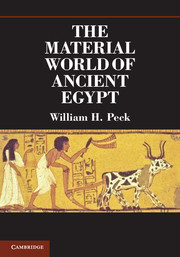Book contents
- Frontmatter
- Contents
- List of Figures
- Preface
- Acknowledgments
- Introduction
- 1 Geography and Geology
- 2 Brief Outline of Egyptian History
- 3 Study of the Material World of Ancient Egypt
- 4 Dress and Personal Adornment
- 5 Housing and Furniture
- 6 Food and Drink
- 7 Hygiene and Medicine
- 8 Containers of Clay and Stone
- 9 Tools and Weapons
- 10 Basketry, Rope, Matting
- 11 Faience and Glass
- 12 Transportation
- 13 Sport and Games
- 14 Music and Dance
- 15 Weapons and Armor
- 16 Conclusions
- Sources of Chapter Heading Quotations
- Bibliography
- Index
Sources of Chapter Heading Quotations
Published online by Cambridge University Press: 05 August 2013
- Frontmatter
- Contents
- List of Figures
- Preface
- Acknowledgments
- Introduction
- 1 Geography and Geology
- 2 Brief Outline of Egyptian History
- 3 Study of the Material World of Ancient Egypt
- 4 Dress and Personal Adornment
- 5 Housing and Furniture
- 6 Food and Drink
- 7 Hygiene and Medicine
- 8 Containers of Clay and Stone
- 9 Tools and Weapons
- 10 Basketry, Rope, Matting
- 11 Faience and Glass
- 12 Transportation
- 13 Sport and Games
- 14 Music and Dance
- 15 Weapons and Armor
- 16 Conclusions
- Sources of Chapter Heading Quotations
- Bibliography
- Index
Summary
Introduction: Herodotus, Histories, Book II, 35, trans. A. D. Godley, Loeb Classical Library, Cambridge, 1920
Geography and Geology: The Land: Diodorus Siculus, Histories, Book I, 36, trans. C. H. Oldfather, Loeb Classical Library, Cambridge, 1968
Brief Outline of Egyptian History: Sir Alan Gardiner, Egypt of the Pharaohs, Oxford, 1964
Study of The Material World of Ancient Egypt: Adolf Erman, Life in Ancient Egypt, trans. H. M. Tirard, London and New York, 1894
Dress and Personal Adornment: “The Prayers of Paheri,” M. Lichtheim, Ancient Egyptian Literature, Vol. 2, p. 16, Berkeley, 1976“The Instruction of Amenemope,” M. Lichtheim, Ancient Egyptian Literature, Vol. 2, p. 157, Berkeley, 1976
Housing and Furniture: From the tomb of Rekhmire in Thebes, quoted in T. G. H. James, Pharaoh’s People, London, 1984
Food and Drink: From a memorandum of payment owed, quoted in T. G. H. James, Pharaoh’s People, London, 1984
Hygiene and Medicine: From a letter, quoted in T. G. H. James, Pharaoh’s People, London, 1984
Containers of Clay and Stone: From the “Satire of the Trades,” M. Lichtheim, Ancient Egyptian Literature, Vol. 1, p. 186, Berkeley, 1973
Tools and Weapons: From the “Satire of the Trades,” T. G. H. James, Pharaoh’s People, London, 1984
Basketry, Rope, Matting: From a letter, Edward Wente, Letters from Ancient Egypt (No. 231, Dynasty Nineteen), Atlanta, 1990
Faience and Glass: From a stela dated to early Dynasty Nineteen, catalog No. 166, in Gifts of the Nile: Ancient Egyptian Faience, Providence, 1998
Transportation: Caption to a tomb scene, Nigel C. Strudwick, Texts from the Pyramid Age, p. 417, Atlanta, 2005
Sport and Games: Excerpt from the “Sphinx Stela,” M. Lichtheim, Ancient Egyptian Literature, Vol. 2, p. 41, Berkeley, 1976
Bibliographical Note
There have been many attempts to describe daily life in ancient Egypt. Sir John Gardner Wilkinson’s Manners and Customs of the Ancient Egyptians (1837–41) and Adolf Erman’s Life in Ancient Egypt, translated into English in 1894, were among the first attempts to approach the subject in depth, and both have had a lasting influence on the modern appreciation of life in the land of the Pharaohs.
- Type
- Chapter
- Information
- The Material World of Ancient Egypt , pp. 203 - 204Publisher: Cambridge University PressPrint publication year: 2013

